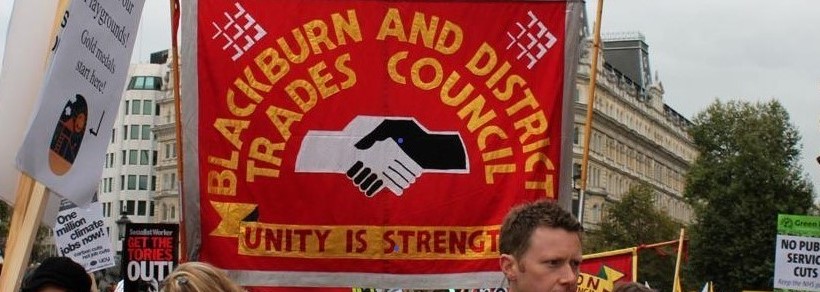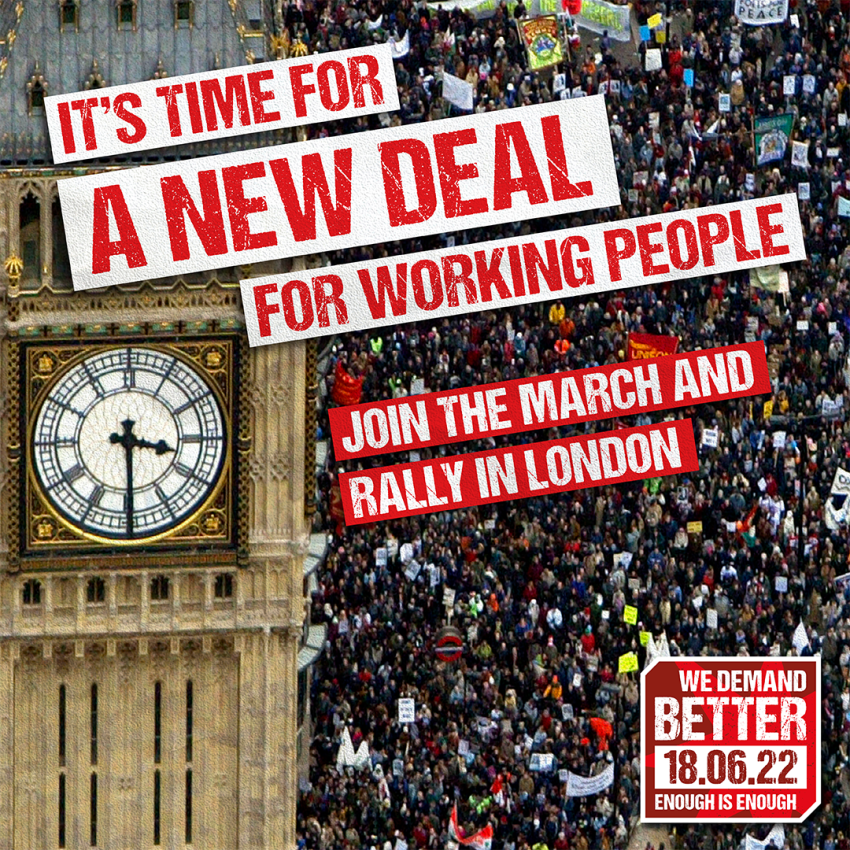It suits the Government to present the current inflationary pressure on our living standards as something very abstract and global, that nobody is responsible for. It is a helpful explanation if you want to say that there is only so much that can be done and that everybody is, to a greater or lesser degree, at the mercy of forces that nobody can fully control.
We should be modest enough to appreciate that we are still too close to events for economists, let alone interested amateurs, to have sufficient information on which to reach firm conclusions. The Russian Federation’s invasion of Ukraine has undoubtedly had, and will continue to have, a serious economic impact – but the roots of the problem are clearly deeper than this; inflation in the USA had already tripled from 2.5% in January 2020 to 7.5% in January 2022, before the Russian government launched its war.
There are, moreover, other features of the situation which we can identify as worth more detailed examination.
It is significant, for instance, that the rate of inflation seems to be different in different countries and that the range is quite wide:
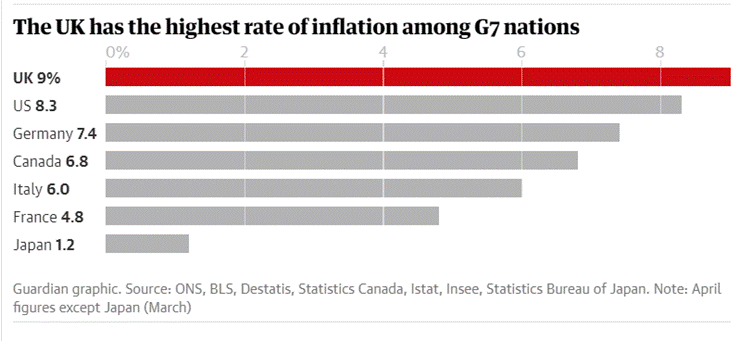
This may still be subject to variation over time, but it suggests that the position in Britain may have been exacerbated by some specific domestic policy decisions or something particular about our relationship with world markets.
Two possible domestic culprits are Brexit and the way we manage the sale and distribution of energy.
Bakker et al., in their April 2022 paper “Post-Brexit imports, supply chains, and the effect on consumer prices” wrote: “Our estimates suggest that, over the two years to the end of 2021, Brexit increased food prices by approximately 6% overall. Products with high EU import shares such as fresh pork, tomatoes, and jams were more affected than those with low EU import shares such as tuna and exotic fruits like pineapple”. And: “In particular, we show that products more reliant on imports from the EU saw larger increases in prices than those less reliant on the EU both immediately after the 2019 election and the implementation of the TCA” (the TCA is the Trade and Cooperation Agreement”).
Their explanation focuses on the introduction of expenses into the supply chain: “The reason for these price increases is straightforward: additional barriers at the border such as checks, increased waiting times, and additional paperwork are costly for producers. Firms could change the partner countries from which they are importing, or purchase domestically, but assuming they were operating in the most efficient manner initially, any change is going to incur extra costs. These costs may then be passed on to consumers, increasing consumer prices”.
Britain’s privatised energy system, and especially the privatisation of distribution, charging and certain elements of production, has long been held to have made consumer prices higher than they need to be. Hall et al., in their 2009 PSIRU Report Global experience with electricity liberalisation”, commented, for instance, that “Studies estimating what would have happened without privatisation concluded that electricity prices in the UK are between 10% and 20% higher than they would have been without privatisation (Branston 2000; Newbery and Pollitt 1997)”.
Britain’s phoney distribution and charging “market” allows for all sorts of shenanigans that end up costing the customer. Citizens Advice, for instance, in their December 2021 Report “Market Meltdown”, argued that OFGEM’s desire to introduce more “competition” into the energy “market”, combined with ineffective scrutiny, resulted in a rapid growth of unsustainable “supplier” businesses in the early 2010s. Citizens Advice reckoned that “supplier failures since Aug 2021 will cost consumers £2.6 billion – around £94 per customer from 2022” and that “consumers whose supplier failed and were moved to a new supplier saw average price rises of £30/month”.
The profitability of the “Big Six” “supplier” companies is quite volatile, but according to “Open Democracy” on 03/02/2022 “the UK’s Big Six energy companies raked in more than a billion pounds of profit ahead of this year’s record hike in bills. The highest earner, SSE, made £600m alone in profit before taxes, according to annual accounts published by the energy regulator Ofgem….Scottish Power and Centrica, which owns British Gas, made a further £423m before tax between them. EDF Energy and E.ON recorded losses of £154m and £198m respectively”.
The “Guardian”, on 19/01/2022, pointed out that “The returns that the big six offer to shareholders through dividends and stock buybacks far outstrip their returns to the public finances through tax payments. Since 2010, the big six have spent more than £40bn on shareholder payouts…..”.
A March 2022 “Common Wealth”report, “Profiting Amid the Energy Crisis”, revealed that the major electricity distribution network operators (DNOs) and gas distribution networks (GDNs), at the heart of the UK’s energy sector, were amongst the most profitable companies around: “electricity distribution is at the top of the list with eye-watering operating profit margins (operating profits / revenues) of 42.5%. Gas distribution is a close second in the table, with profit margins of 40.5%. Not even the private equity firms and major tech companies come close to reaching such levels of profitability”.
The raw fuel companies at the start of the energy supply chain have received most public attention. Referring to their profits as “windfalls” gives the impression that they simply had the good fortune to stumble across them whilst out for a Sunday walk. It is perhaps more plausible, however, to see them as part of a wider corporate response to market developments that was one of the main roots of the current inflation across the board – though it has been of different intensities according to sector.
Michael Burke, in a “Socialist Economic Bulletin” blog has suggested that a primary root for the current inflation can be found in the stimulus packages associated with the response to the COVID pandemic – “Trump, Bush and Johnson are to blame for the cost of living crisis”. The problem, in his view, is not so much that there was state intervention, but that it was lop-sided. State spending to support consumption should have been balanced by state spending on investment. The fact that it wasn’t meant that: “virtually unchanged productive capacity was unable to meet the effects of surging Consumption plus the exceptional growth in money supply. The result is now the inflationary wave that it is overwhelming living standards for most people in the Western economies and beyond”.
Some Americans, however, have focussed more on the question of how corporations, and particularly “big business”, responded to these stimuli. If we are now being asked to show “wage restraint”, it is because they failed to exercise any sort of “profit restraint”.
Josh Bivens, writing in the “Economic Policy Institute” “Working Economics” blog in April 2022 (“Corporate Profits have contributed disproportionately to inflation”), noted, for instance, that: “Since the trough of the COVID-19 recession in the second quarter of 2020, overall prices in the NFC (Nonfinancial Corporate) sector have risen at an annualized rate of 6.1%—a pronounced acceleration over the 1.8% price growth that characterized the pre-pandemic business cycle of 2007–2019. Strikingly, over half of this increase (53.9%) can be attributed to fatter profit margins…… This is not normal. From 1979 to 2019, profits only contributed about 11% to price growth……. Nonlabor inputs—a decent indicator for supply-chain snarls—are also driving up prices more than usual in the current economic recovery”.

No one seems to have done similar work in respect of British corporations, but it is clear that some were indeed “making hay whilst the sun shines”.
The most egregious examples have been the energy companies. Fossil fuel giant BP announced record profits of £4.9 billion for the first quarter of this year—more than double what it made in the same period in 2021.
Joshua Oliver reported in the “Financial Times” on 27th April that: “Investors in British companies can expect higher dividends this year than previously forecast, as higher oil and commodity prices brighten the outlook for shareholder payouts…… the forces that are pushing energy bills higher have also helped the outlook for UK shareholder payouts, as oil and commodities companies rake in cash and lay plans to return it to shareholders”.
Possibly it is a linked feature that “City AM” reported a study on 19th April 2022 which showed that: “a YouGov survey carried out on behalf of global job site Indeed found triple the number of those financially comfortable (19 per cent) have been offered a pay rise recently to help with the increasing cost of everyday living compared to those who are financially uncomfortable (6 per cent)”. “Not only are higher earners more likely to receive pay increases, they’re also receiving the biggest jumps in pay. For example, of those earning under £25,000 just 5 per cent have been offered a salary rise greater than 7 per cent – to surpass inflation – in comparison to those earning £100,000-£149,999 where 30 per cent were offered more than 7 per cent, and for those earning £150,000 or more, 31 per cent were offered a pay rise greater than 7 per cent”.
The latest data from the Office for National Statistics showed that the people who so far have been able to avoid a real pay cut are those who get their pay supplemented by bonuses:
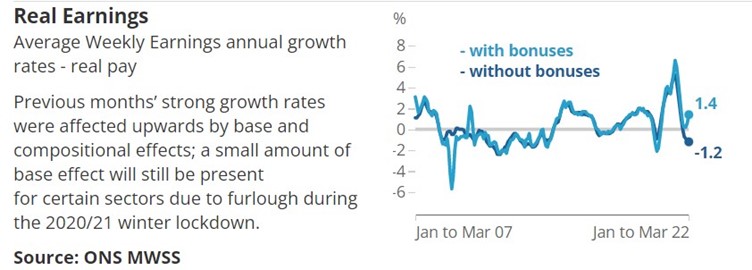
So, inflation in Britain is having an unequal impact on an already unequal society. According to the “Equality Trust”, “Compared to other developed countries the UK has a very unequal distribution of income, with a Gini coefficient of 0.35. According to 2013 data from 19 OECD member states in the Luxembourg Income Study data set, the UK is the fifth most unequal, and fourth most unequal in Europe”

On top of this, the Institute for Fiscal Studies has noted that: “the bottom 10% of the population in terms of income faced an inflation rate of 10.9%, which was 3 percentage points higher than the inflation rate of the richest 10%. Most of this difference comes from the fact that the poorest households spend 11% of their total household budget on gas and electricity, compared to 4% for the richest households”.
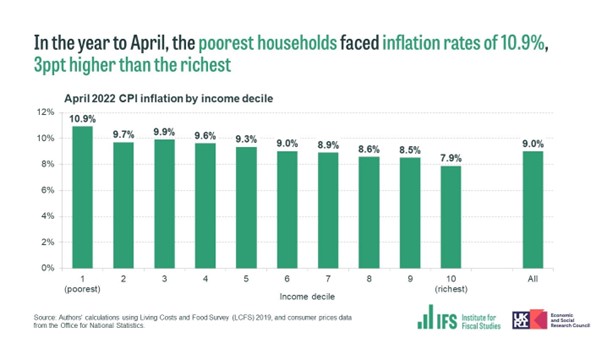
That is even before considering that many Trade Unions maintain the “Retail Price Index” (RPI) is a better measure of the impact of inflation on workers than the “Consumer Price Index” (CPI), which is the measure now mostly cited in the media. UNITE General Secretary, Sharon Graham, has said: “The RPI, which includes housing costs, is a more accurate cost of living index than the CPI, which is always lower as it does not include housing and related costs. Employers favour the CPI as it creates a lower base rate for inflation as an element in possible wage claims. In that respect, the CPI is a hidden tax on workers’ wages if it is used as a base for cost calculations”.
RPI is now, for instance, showing at 11%, compared with the CPI’s 9%.
The “New Economics Foundation” – “Losing the Inflation Race”, 05/05/22 – has calculated that the British Government measures to “ease” the “cost of living” pressure on families still, as a package, will leave the poorest with the least effective help: “Our analysis finds that the richest 5% of families will be £600 better off each year as a result of the fuel duty cut and increase to national insurance threshold combined. The poorest half of households will only see an average increase of £300……For everyone outside of the highest income 5% of families, price increases will exceed any net increases in income following the combination of policy changes that took effect from April 2022 – including tax changes, council tax band rebates and energy bill loans – and wage increases…..The poorest will be worst impacted, with an effective squeeze on disposable incomes of more than 10%….”.
It seems that whether you look at the roots of the cost-of-living crisis, or at its impact, or at the measures that Government might take to relieve it, there continually lurks not far below the surface the basic social tension of class struggle over the distribution of the fruits of social production.
The most helpful policy responses are those that focus on directly controlling prices or on putting money into peoples’ pockets. Those on benefits are especially in need of help. There is scope for the Government to intervene by increasing pensions and benefits, at least in line with inflation. It can impose price controls, especially on fuel and core food items, and address some of the funding through excess-profits taxes (though following the initial engorgement the money is soon distributed, and the second phase of inflation may leave some companies themselves facing balance sheet difficulties).
If the narrative behind the current inflation is like the one offered by Josh Bivens it means that the sort of measures normally arising from the view that generalized macroeconomic overheating is the problem could tip economies into the “stagflation” that already seems to be waiting in the wings.
It is more something along the lines of the manifesto put forward around the TUC’s national demonstration on Saturday 18th June that will define the national response required:
- A real pay rise for every worker – and a real living wage for all
- Respect and security for all workers – ban zero hours contracts, ban fire and rehire, decent sick pay now
- End racism at work
- Tax energy profits to pay our bills
- Raise universal credit
- Boost union bargaining rights now.
It would be a difficult time to take on re-nationalisation of the energy distribution infrastructure, but it is clearly an area where privatisation has been damaging to the public good. The sooner something is done about it the better.
